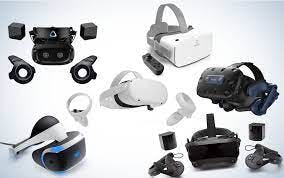Step into the Future: Exploring the Exciting World of Virtual and Augmented Reality Technology.
Table of contents
Virtual and augmented reality (VR/AR) technologies have been around for a while, but they have only recently begun to gain mainstream acceptance. These technologies provide users with an immersive experience that blurs the lines between the physical and digital worlds. In this article, we will look at the world of VR/AR technology, how it works, and what applications it could have.
What exactly is Virtual Reality (VR)?
Virtual reality is a technology that creates an entirely artificial environment in which the user can interact. It usually entails wearing a headset that displays a digital image in front of the user's eyes while tracking their movements to create a sense of immersion. The user can interact with the virtual world by using hand-held controllers or, in some cases, by moving their body.
What exactly is Augmented Reality (AR)?
Augmented reality is a technology that superimposes digital elements on real-world environments. This is typically accomplished with the help of a smartphone or tablet camera, which displays the real world on the screen while also overlaying digital elements. AR can also be used in conjunction with special glasses that project digital elements directly in front of the user's eyes.

How do VR/AR technologies function?
To create an immersive experience, both VR and AR technologies rely on a combination of hardware and software. In the case of virtual reality, this usually entails a headset that displays a digital image in front of the user's eyes, as well as hand-held controllers that allow the user to interact with the virtual world. AR, on the other hand, is based on a camera that captures the real world and software that overlays digital elements.
Applications of VR/AR Technology.
- Entertainment:
The entertainment industry is one of the most popular applications of VR/AR technology. Virtual reality headsets are already being used to create immersive gaming experiences, while augmented reality (AR) is being used to add digital elements to live events such as concerts and sporting events.


- Education:
By creating immersive experiences that help students better understand complex concepts, VR/AR technology has the potential to revolutionize the way we learn. Medical students, for example, can use VR to simulate surgeries, while history students can use AR to visit historical sites and see how they were in the past.
- Retail:
Retailers are already using augmented reality technology to create virtual showrooms where customers can see how furniture or clothing would look in their homes. VR could be used to create fully immersive shopping experiences in the future, allowing customers to explore virtual stores and try on clothes without leaving their homes.
- Healthcare:
Healthcare VR/AR technology is also being used to treat conditions such as anxiety and PTSD in the healthcare industry. For example, virtual reality exposure therapy allows patients to confront their fears in a safe environment, whereas augmented reality (AR) can be used to overlay digital information onto a patient's medical records during surgery.
Challenges of AR/VR Technology:
Despite the numerous potential applications of VR/AR technology, several challenges must be addressed. These are some examples:
Cost: VR/AR technology is not cheap, especially when it comes to high-end headsets and other hardware.
Comfort: When using VR headsets, some users may experience discomfort or nausea, especially if the image quality is poor or the motion tracking is inaccurate.
Content: There is still a relatively small amount of VR/AR content available, particularly in terms of high-quality experiences.
Accessibility: VR/AR technology may not be available to everyone, especially those with disabilities or who cannot afford the required hardware.
Conclusion
VR/AR technology has the potential to change the way we interact with our surroundings. From entertainment to education, healthcare to retail, these technologies provide a more immersive and engaging way of experiencing digital content than ever before.